They say that moving is one of the most stressful things you can do in life. They also say that a full belly means a happy heart. This duality in concepts is the only reason I can think why Kate Pincus-Whitney was so kind as to take a meeting with me in the middle of a life-altering move to Los Angeles, California. Raised in the kitchen within a close-knit family, P. W. is passionately committed to compose the dinner table as a theater setting. As you’ll read below, these acrylic and Polycolor paintings are as vivid and colorful as they are delicious to look at. The artist dives in her research of objects, specifically objects that can reflect upon the viewer the essence of a given person. We can only get excited to see what she will come up with next, in the continuous narrative through food and the dinner table.
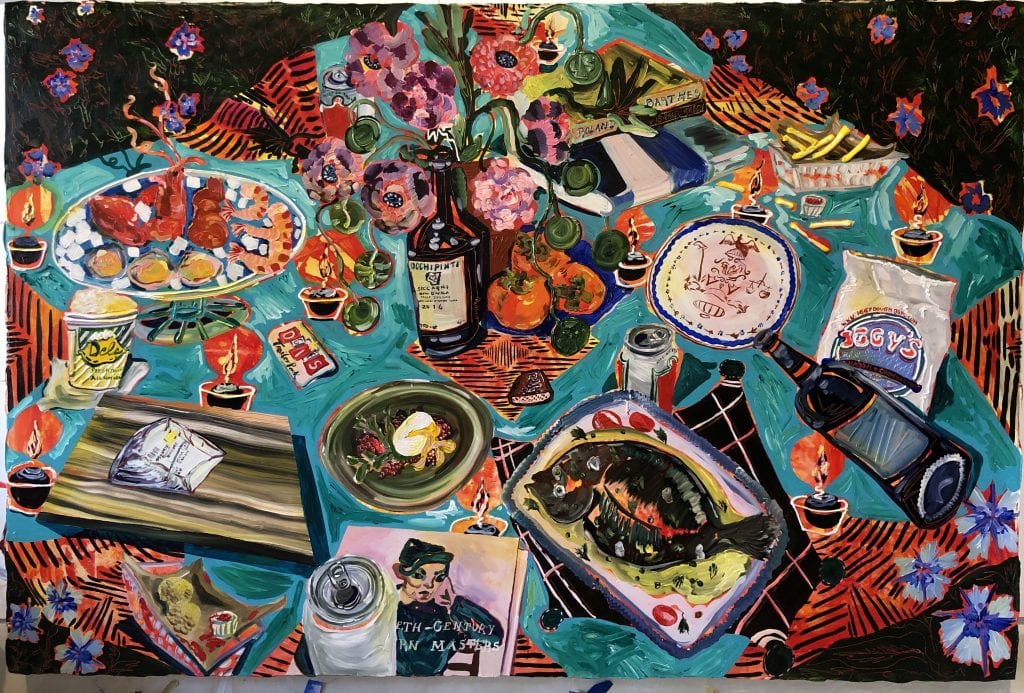
Feast in the Neon Jungle: Last Picnic in Providence, 2020, Acrylic and Polycolor on Canvas, Courtesy of the Artist and Fredericks & Freiser, NY, Photography by Cary Whittier
Where are you from and when did art first enter your life?
I was born in Santa Monica, California and when I was about 1.5 years old we moved up to Santa Barbara. It’s funny, I can’t really tell the moment art entered into my life because it had always been present. I am very lucky to have been born into an extremely creative family. My mother was an LA artist, and much of my childhood was filled with paint, large wooden sculptures etc. And my Grandfather on my paternal side, John Whitney, was one of the first experimental filmmakers working in the 50s and 60s. Growing up, art was sacred. Art wasn’t just a creative act but a way of looking and synthesizing the world around me. This is something I was taught from a very young age. Also, early on I knew I was different. Being dyslexic and stereo blind (meaning I don’t perceive depth in the typical way) I always felt more comfortable and fluent interacting and understanding the world through the visual language instead of the written word. I will say though, at 16 I lost my grandmother, and this was a deeply pivotal moment for me and my creative practice. All of a sudden struck with loss, I started asking larger existential questions, like how do you capture the essence of someone? Or your relationship to them? This was the moment I started engaging with portraiture, and the vitality of objects in a more intense and meaningful way through paint.
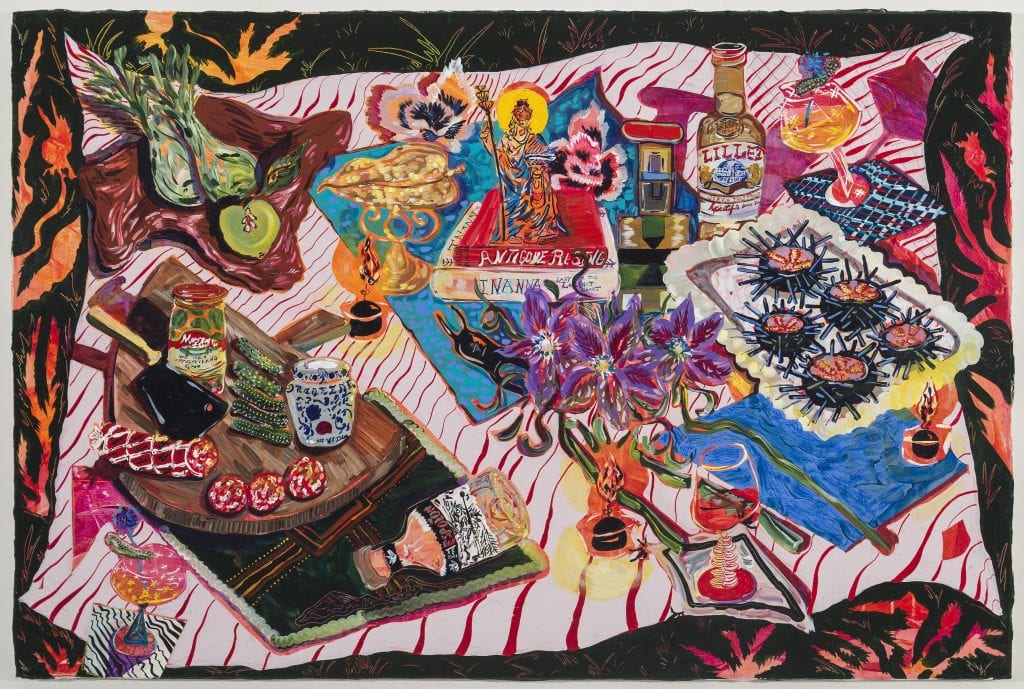
Feast in the Neon Jungle: Home Harvest, 2020, Acrylic, Polycolor, and Oil Pastel on Canvas, Courtesy of the Artist and Fredericks & Freiser, NY, Photography by Cary Whittier
Has your work always taken on the style it currently embodies?
Stylistically I have always been unapologetically maximalist, colorful, and loud. I engage formally and obsessively with paint and wood carving. I work from a combination of life and image, and really think of the canvas as a stage for all of life’s dramas. When it comes to my style, it has always been the natural way my hand interacts with material. I honor that. It’s funny, I have always been able to paint and draw hyper realistically, but I like to engage in a more initiative and ritualistic manner with my materials. I think my stereo blindness also plays a huge role my style, especially the way I deal with space and depth. I play a lot with the Gestalt principles of perception and neurological depth cues. I have a natural fluency in flatness. As my work has evolved, the literal figures may have left, but I still think of each of my pieces as a portrait.
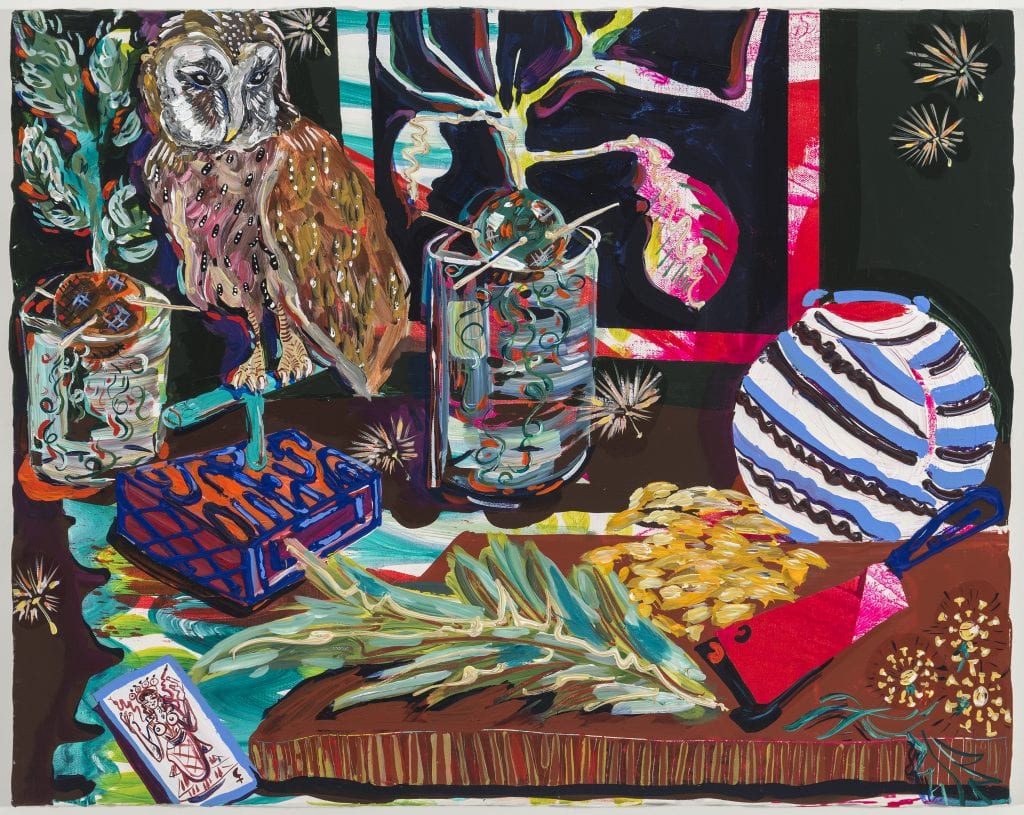
Faith in a Weed with Lilith, 2020, Acrylic and Polycolor on Canvas, Courtesy of the Artist and Fredericks & Freiser, NY, Photography by Cary Whittier
What is your process like? How do you begin a work?
As in any recipe, mine begins in the studio with a hunger and a low growl radiating from my belly. I think about the psychological hunger to connect, to dialogue, to question, to investigate the phenomenological, the historical, and the mystical. When it comes to process, I really engage with my work through series. I typically begin with a threshold of questions I can jump through as I begin feeding my palate with images, readings, art historical references etc. I also do something a little strange. Under every painting I make abstract words, phrases, and poems as the first formal interaction with the canvas. This first layer allows me to engage very physically with each individual canvas. It almost feels alchemical in its ritualistic nature and allows for a more ab-ex dialog to start the works. It is an important part of the magic. Once I have my surfaces primed, I typically work on one painting at a time. I think this allows for a more intense one on one dialog.
When it comes to series, like my Theater of the Dinner Table paintings I began working on wooden doors, turning them horizontally to become table theaters. Sometimes I find myself inviting deities or heroines to be honored with a feast. Combining ancient myths, coaxing out deities’ gifts with plates filled with fresh sea urchins. Hecate, Dionysus, Marisol’s American Cowboy, Picasso’s goat heads are all players of these roles. Appropriating theories from Joseph Campbell’s myth structure, objects in my paintings exist on layered levels- psychological, sociological, cosmological, and mythical. As I mentioned earlier, I really think of each of my paintings as narrative still life portraits dealing with time, place, relationship, longing, and self.
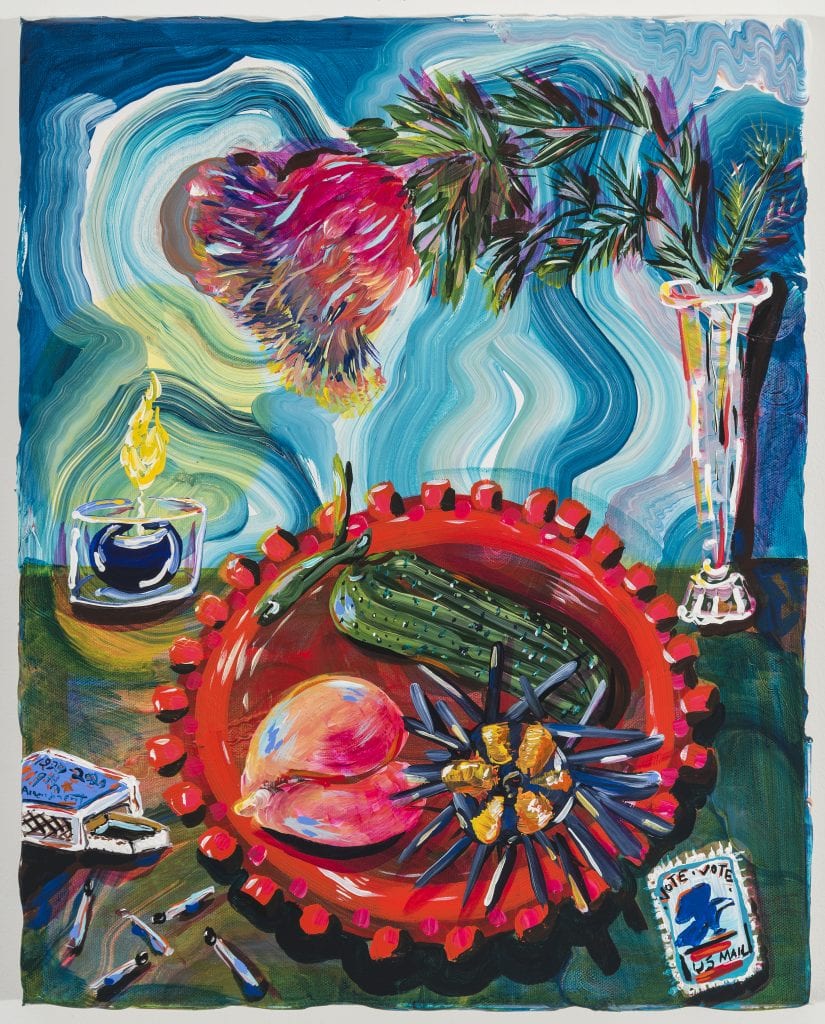
Americana Still: Resilience of Light, 2020, Acrylic and Polycolor on Canvas, Courtesy of the Artist and Fredericks & Freiser, NY, Photography by Cary Whittier
Walk us through a day in the studio.
Since quarantining, my studio is also my house. My partner and I are both artists, so my day is essentially I wake up, put on my tea, and get to work. Then I make something to both feed myself, but also to use as inspiration in my studio.
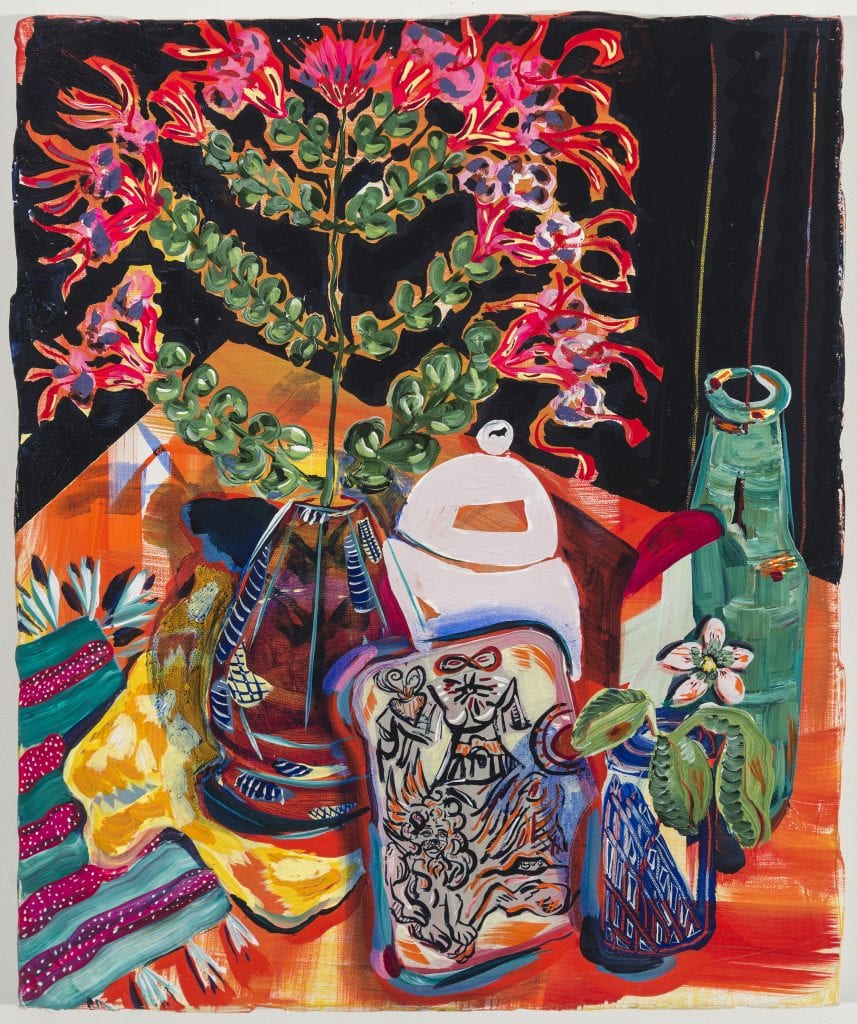
Naturelza Muerta: Americana Still III, Acrylic and Polycolor on Canvas, Courtesy of the Artist and Fredericks & Freiser, NY, Photography by Cary Whittier
From where do you draw inspiration?
As you can probably tell by now, I have a ferocious appetite. I really fill my palette with as much information and content as I can, and for me, nothing is taboo.
Investigating the object identities of things, all with their own histories, each item plays their part in the dramas of the theater of the dinner table. Object roles expand from symbolic to metaphoric, playing upon cultural associations and histories forming their own sort of theater troops. Federico Fellini films are as inspiring to me as the writings of Joseph Campbell or Carl Jung. The lyrics and music of Billie Holiday play as much of a role as looking at one of Toulouse-Lautrec’s paintings or my grandmothers vintage recipe books.
Maya Angelou once said “people will forget what you said, they’ll forget what you do, but they’ll never forget the way you made them feel”. I believe that’s what I want for my paintings, and the way to do it is to welcome everything and anything to come into my studio.

Breakfast with the BauHaus, 2020, Acrylic and Polycolor on Wooden Door with Carving, Courtesy of the Artist and Fredericks & Freiser, NY, Photography by Cary Whittier
Tell us about your relationship with food. What’s your favorite food to make?
Oh (laughs) this is a very hard one. There are two things I love most in this world, painting and food. I was raised by my grandmother in the kitchen and food for us was everything; it was identity, history, love, and ritual. We made everything from latkes to Szechuan.
I think one recipe that really hits home is my French Pork Chops. I do them with a Tarragon Cream sauce, and a celery root puree. Also, French Poached leeks with a mustard vinaigrette topped with a dash of aged parmesan… it’s really really good.
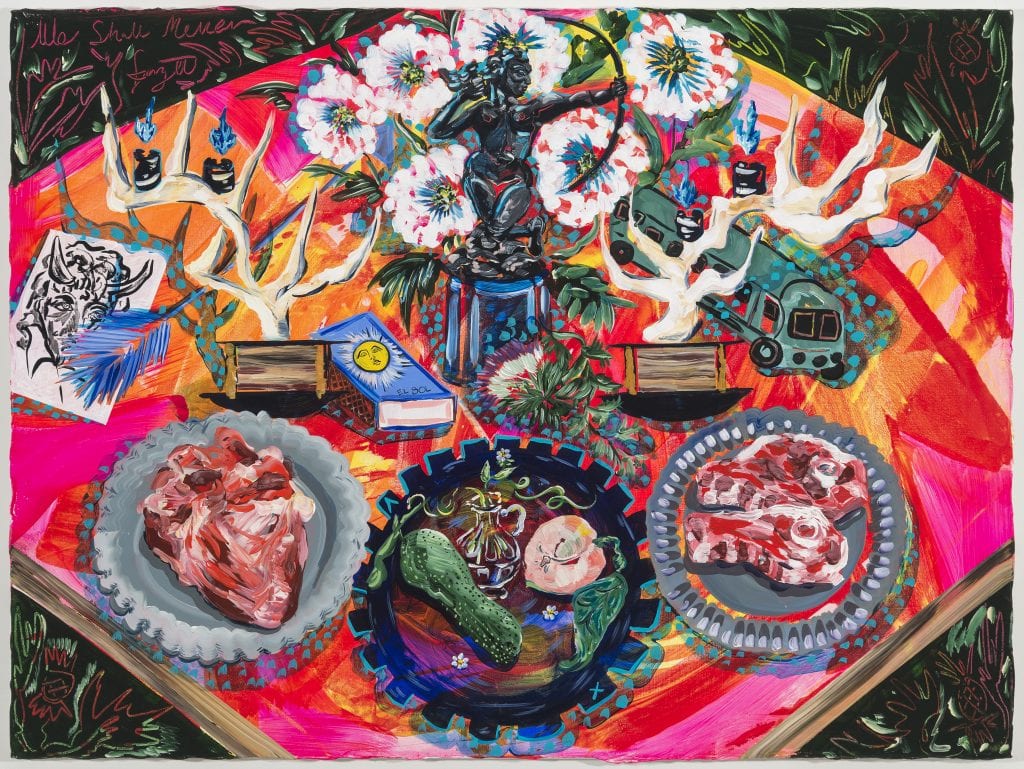
Feast in the Neon Jungle: The Huntress Diana Cazadora, 2020, Acrylic and Polycolor on Canvas, Courtesy of the Artist and Fredericks & Freiser, NY, Photography by Cary Whittier
Have you ever delved in other forms of craft? Why or why not?
I used to do set design in theater, which is when I fell in love with woodworking. Even when I was taking my masters in painting, I was working cross disciplines, working with ceramics and pouring aluminum sculptures. All of it was a fantastic experience… Like I said, nothing is taboo. I have always loved and been deeply inspired by the vibrancy of material and I really enjoy anything I can get my hands on. Now that we’re moving to LA, I’ll have so much more space, and I’m looking forward to creating works that can come out of the surface to dialog with the paintings.
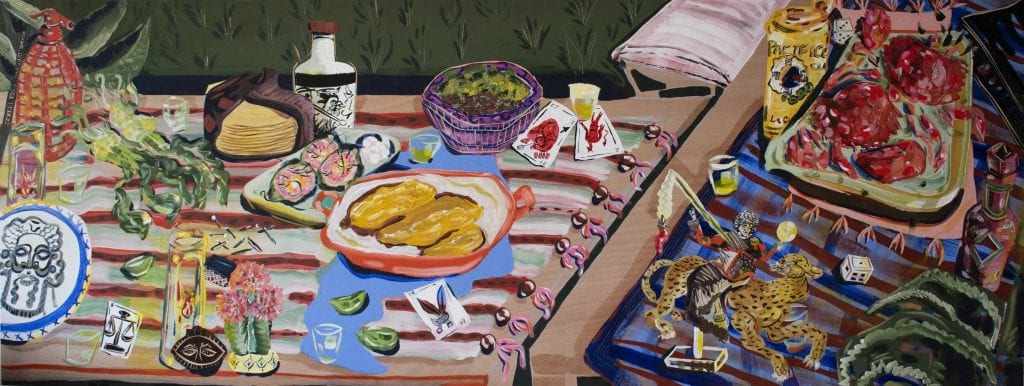
Dionysian Drinking Games, 2020, Acrylic and Polycolor on Wooden Door with Carving, Courtesy of the Artist and Fredericks & Freiser, NY, Photography by Cary Whittier
Does your work reference any Art Historical movements?
Each work takes on its own specific critique or acknowledgement of artists and movements that have come before me. I love the Nabi, Fauvists, and symbolists with all my heart and I feel they are ever present in my studio. Working in the realm of investigating objects, I am aware of their loaded histories, artistic and otherwise- where a Coca-Cola bottle in Tom Wesselmann’s Still life series is understood not simply as a coca cola bottle, but instead an icon of American identity. Or like with Morandi, a custard cup is not simply a cup- it is holding space as Madonna and Child.
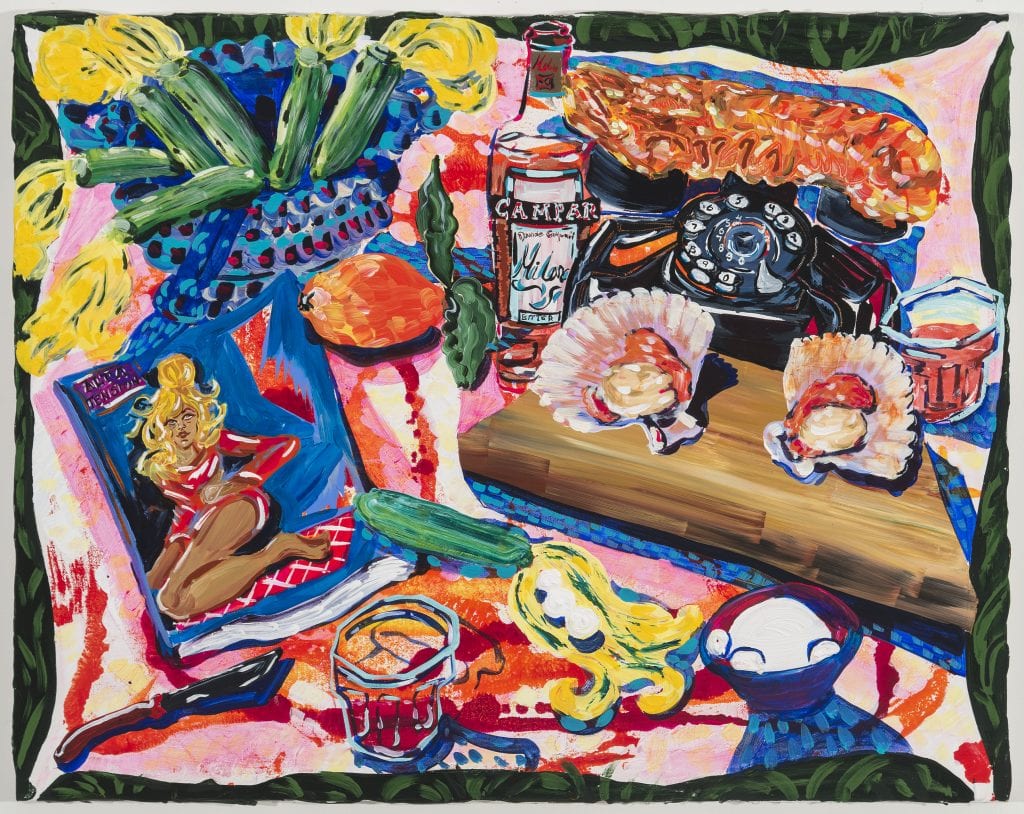
Feast in the Neon Jungle: Dreams from Cefalu (You can call me on my shell phone), 2020, Acrylic and Polycolor on Canvas, Courtesy of the Artist and Fredericks & Freiser, NY, Photography by Cary Whittier
What’s next for you?
Well, I’m very excited about my upcoming solo debut at Fredericks & Freiser! I could not be more grateful to be working with a fantastic gallery with such a great history. I am also in the process of moving to Los Angeles and I cannot wait to get my new studio space all set up and rolling.
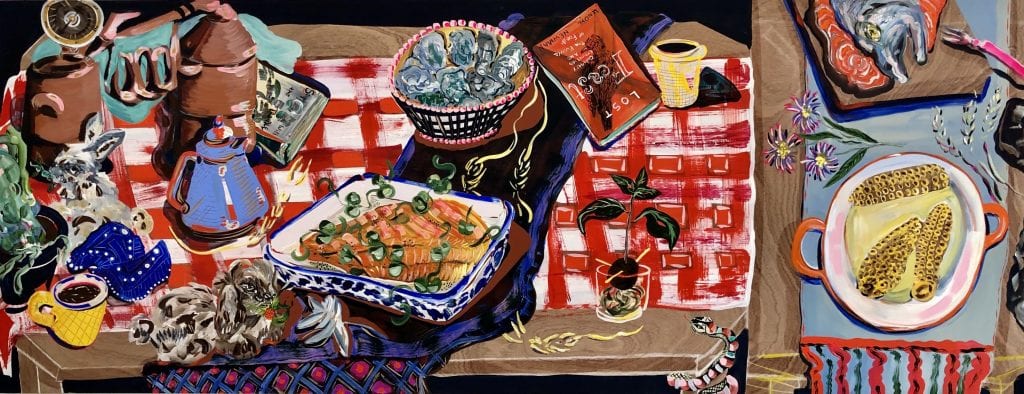
The Real McCoy. Looking Gone Looking For America, 2020, Acrylic and Polycolor on Wooden Door with Carving, Courtesy of the Artist and Fredericks & Freiser, NY, Photography by Cary Whittier
At the end of each interview we like to ask the artist to recommend a friend whose work you love and would like for us to interview next. Who would you suggest?
I love my partner Merrick Adam’s work. I think what he is doing with abstraction, process, and material is really exciting.